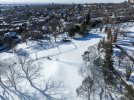This is why we let our telescopes and other optical devices acclimate when star gazing. From a warm house to cold outside or worse from a cold inside to hot outside. I have noticed in the winter , the haze formed for a few minutes on the camera protector. Never though about the sensors. It is the reason max defrost uses cold AC across the inside of a car windshield. Warm in cold out, makes fog.
I taught this stuff to architecture students years ago. Pardon me for resurrecting it, Ignore at will. I'm putting off going outside to finish some landscaping work.
Condensation forms when the air over a surface drops below the dewpoint temperature, which can happen with cooling or humidification. Dewpoint temperature is simply the temperature at which the air is 100% saturated with humidity - 100% relative humidity. Warm air can hold more moisture per pound (absolute humidity) than cool air.
In winter, if you bring a cold-soaked camera from outdoors inside a conditioned building, the cold surfaces can chill the warmer, more humid indoor air below the dewpoint and condensation will form. In summer, if a camera is moved from a cool building interior to the warm, humid outdoors, the same thing occurs. You may also have condensation during winter when the camera is moved from a warm dry interior to a cool, moist outdoors, though not as often. (Absolute humidity, rather than relative humidity)
Ralph Thompson's plastic bag suggestion is a good one. I've done that with drones, cameras, phones, and tablets to let their temperature stabilize before exposing them to our humid coastal air during the air conditioning season. (One fortunate thing with drones is that the downdraft from the rotors very quickly warms the exterior lens sufaces and eliminates the fog on the surface.)
An automobile windshield fogs up on the inside because the glass gets cooled from outside or the people inside exhale and perspire water vapor into the interior air. The defroster system uses the air conditioner to cool interior air down below the dewpoint (100 relative humidity) to condense out water vapor and drain it out the bottom of the car. Then it heats ups that same air so it can hold even more moisture and blows it over the fogged windshield. It boosts the moisture-holding capacity of the defrost air both by directly removing moisture and by raising its temperature.












